The question on “how to do this with a shared mailbox” is quite common, and the usual answer more often than not remains “add the shared mailbox as additional account in Outlook”. Doing this will expose all the “native” functionalities, including access to Inbox rules, signatures, auto-reply, add-ins, categories, proper search experience, Mail merge, and more. As a general rule of thumb – if you can do something with your regular mailbox, you can do it with a shared mailbox too, as long as it is added the “right” way. This is even needed for “advanced” features that require additional licensing, such as access to the Online archive for a shared mailbox.
Usually, when users are granted access to a shared mailbox, the Automapping functionality is utilized. This is in fact a helpful feature, as it will ensure that the shared mailbox will automagically appear in the user’s Outlook, without them having to perform any additional configuration. As is often the case however, usability comes at a price, in this case the limited set of features being exposed. So while this method might sound convenient at first, you should always check with the user on how they plan to use the shared mailbox and which features they will utilize. Then, use the Add-MailboxPermission cmdlet to grant them Full Access, while toggling the Automapping flag off.
If Automapping isn’t used, the user will have to perform some additional steps in order to access the shared mailbox. Usually, this is done by going to File > Account Settings > Account Settings > double-clicking the user’s account > More settings > Advanced > press the Add button under the “Open these additional mailboxes” section. Another scenario where you would use this method is when you are granting folder-level access instead of Full Access.
I’ve also seen quite few people go the “unsupported” route of logging in to a shared mailbox directly. Yes, this is technically possible in Exchange Online, always has been. However, it is not something that Microsoft supports and while it’s hard to find a document that clearly spells this scenario as going against the license agreement, rest assured that this is not something the licensing folks will approve of.
So after this lengthy introduction, let’s finally go over the steps to add a shared mailbox as additional account in Outlook. Unless otherwise noted, the instructions below apply to the most recent click-to-run version, which at the time of writing is Version 2110 (Build 14527.20276 on the Current channel).
To start with, hit the File menu, then under the Info pane, hit the Add account button:
 You will then be presented with the (not so) new Add account dialog, which will try to help you with the process. It would be nice if there was a mechanism that would list all the shared mailboxes you have access to at this point, however this is not yet the case, so just wait for the “searching for accounts” phase to end:
You will then be presented with the (not so) new Add account dialog, which will try to help you with the process. It would be nice if there was a mechanism that would list all the shared mailboxes you have access to at this point, however this is not yet the case, so just wait for the “searching for accounts” phase to end:
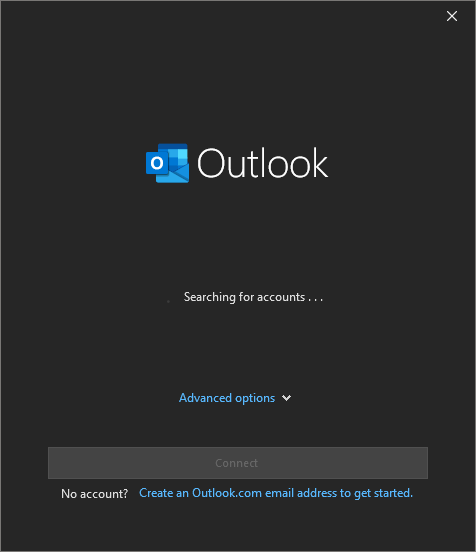 Once you get to the next phase, you will be presented with a dropdown of all “detected” accounts. Do not expect the shared mailbox to appear here. Instead, place the cursor in the Email address field and type in the SMTP address of the shared mailbox you have been granted access to. This is an important/mandatory step, if you do not know the address, ask your IT folks to provide it.
Once you get to the next phase, you will be presented with a dropdown of all “detected” accounts. Do not expect the shared mailbox to appear here. Instead, place the cursor in the Email address field and type in the SMTP address of the shared mailbox you have been granted access to. This is an important/mandatory step, if you do not know the address, ask your IT folks to provide it.
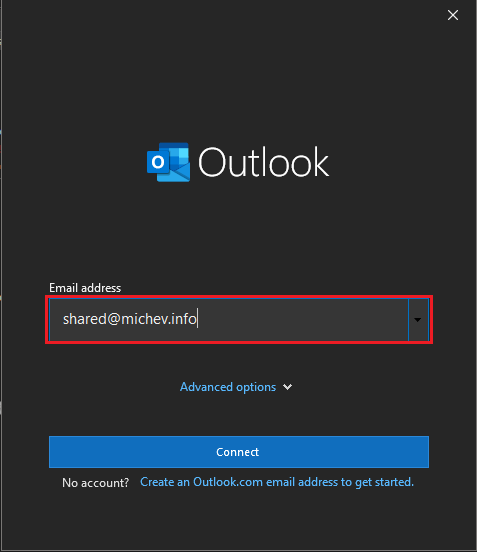 Once you have entered the address of the shared mailbox, press the Connect button. Outlook will issue an autodiscover request and once it validates the address, it will present you with a credentials prompt. It’s the year 2022, so you should something similar to the below. If the prompt looks differently, you are likely using an outdated version of Office and/or Windows. Refer to the links at the end of the article for detailed steps in such scenarios.
Once you have entered the address of the shared mailbox, press the Connect button. Outlook will issue an autodiscover request and once it validates the address, it will present you with a credentials prompt. It’s the year 2022, so you should something similar to the below. If the prompt looks differently, you are likely using an outdated version of Office and/or Windows. Refer to the links at the end of the article for detailed steps in such scenarios.
Now, this is the most important part of the process. As you can note from the screenshot below, the credentials we are being asked to provide are for the shared mailbox account. This is not what we should do. Instead, press the Sign in with another account link, as highlighted below:
This will take you a step back to the initial login screen, where you need to enter the username. Make sure to enter your *own* UserPrincipalName here, in the format user@domain.com. Some variations might apply depending on how authentication is handled in your organization, but the thing to keep in mind is that you should be providing your own credentials!
Once you enter the username, press the Next button and complete the authentication request. Again, depending on the tenant setup, and the authentication methods configured for the given account, the steps will differ here. In my case, a passwordless authentication prompt was triggered, as shown below:
If everything goes OK authentication-wise, the process is now complete and Outlook will present you with the following dialog. As stated therein, you need to restart Outlook for the changes to take effect, so go ahead and do so at this time.
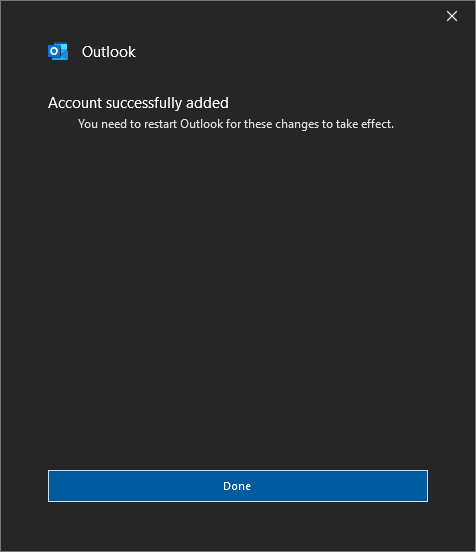 After the restart, you should see the shared mailbox as a new entry on the left nav pane, as well as under the File > Accounts dropdown menu or the File > Account Settings dialog. And, you should now have all the desired features exposed, just like you have with your own mailbox. For example, under the Manage Rules & Alerts dialog, you will now have a separate entry for the shared mailbox we just added, and you can manage rules for it:
After the restart, you should see the shared mailbox as a new entry on the left nav pane, as well as under the File > Accounts dropdown menu or the File > Account Settings dialog. And, you should now have all the desired features exposed, just like you have with your own mailbox. For example, under the Manage Rules & Alerts dialog, you will now have a separate entry for the shared mailbox we just added, and you can manage rules for it:
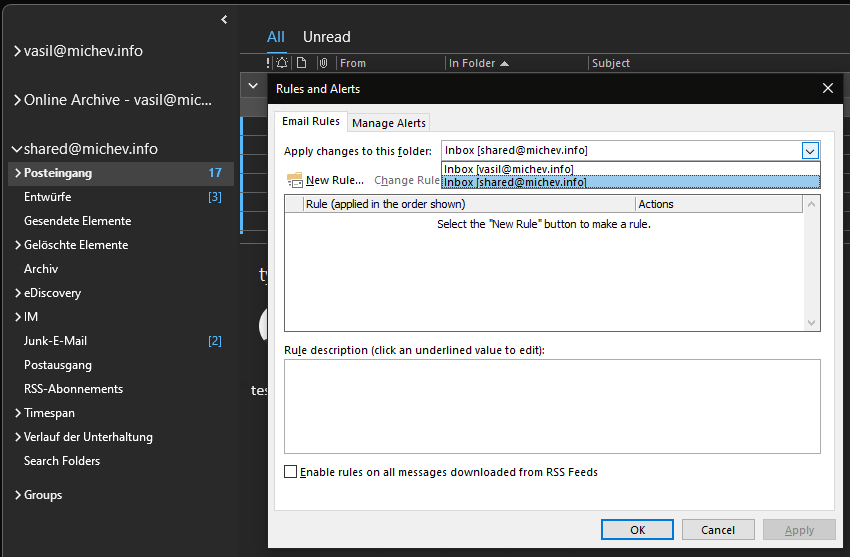 In case you are using older version of Office and/or Windows, refer to the previous articles here and here.
In case you are using older version of Office and/or Windows, refer to the previous articles here and here.
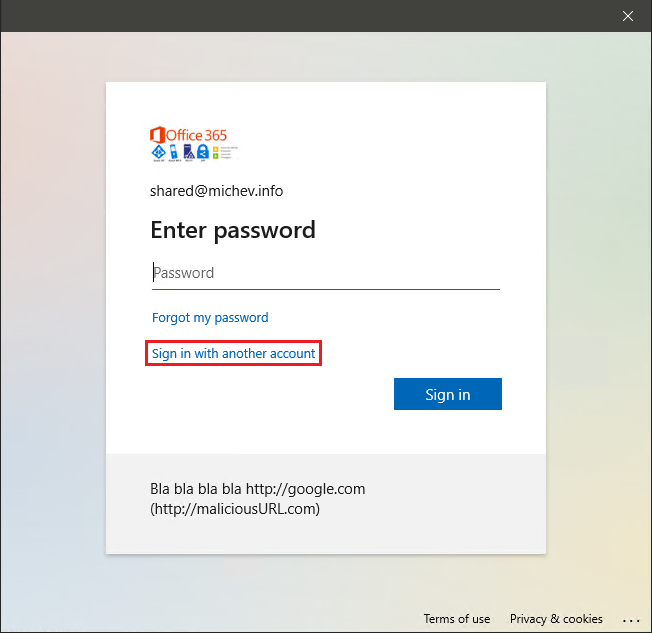
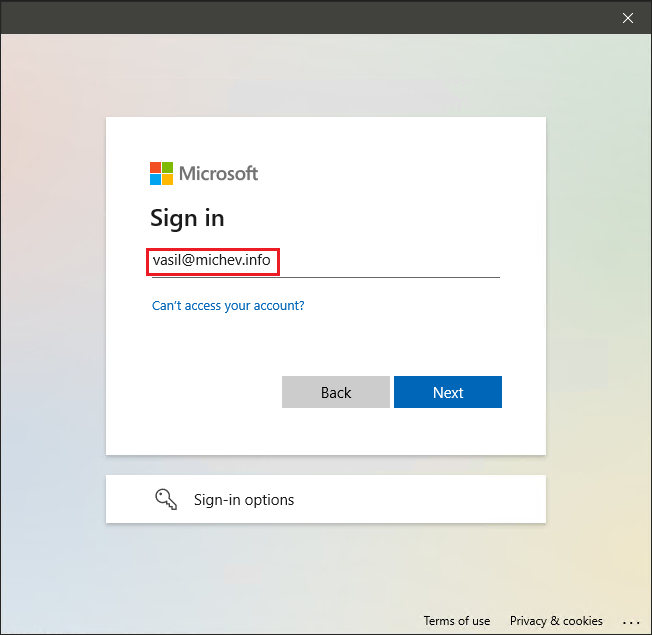
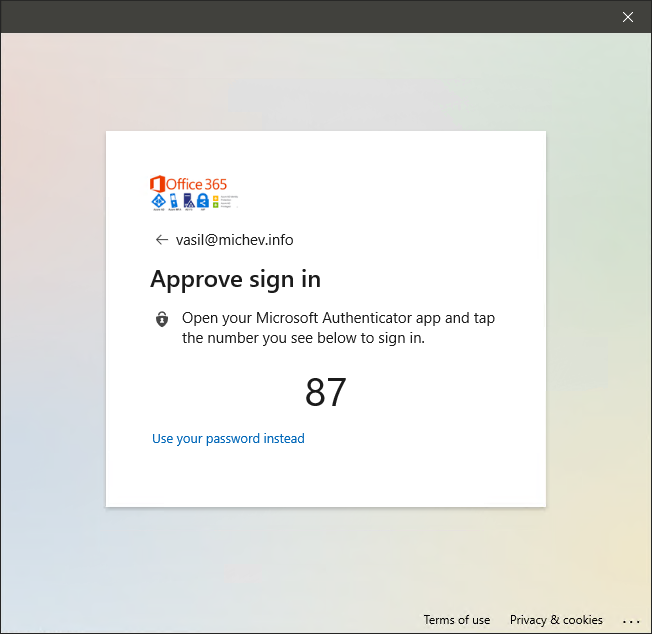
Hello Vasil, is this or a similar approach also possible with delegated mailboxes (with open and send as privileges)? When adding a delegated mailbox, Outlook seems to just expecting the login credentials of that mailbox and offers no option to use credentials from a different account (which makes sense).
Should be available for any type of mailbox for which you have been granted Full access permissions. Keep in mind that the new Outlook does not yet support this method, only the “classic” one does.
How would we do this in the New Outlook?
It’s not possible in the new Outlook just yet, though Microsoft is working on it.
Hello, I disabled automapping, added the shared mailbox as additional mailbox (like you describes). The only problem is when I want send mail from the shared mailbox then the email stuck in the outbox folder and can’t be send. Do you have solution?
The user will need to have Send As permission to the shared mailbox in order to send messages from that mailbox. Most of the times, Send On Behalf is the permission used, but this will not work if you have added the mailbox as a separate mailbox in Outlook
We have teh ame issue withoout client, any new advice?
Same issue we face, any advice?
Hi, does this work only when sharing the entire mailbox.
I’m trying to give only full permissions to certain folders of a shared mailbox. So I’ve added permissions to the mailbox to make it visible only and then added full permission to certain folders. When I followed your steps my mailbox showed up on the tenant machine but nothing could be viewed.
Thanks
Only works with Full access (mailbox level) permissions, yes.
Hy Vasil
Is there an opportunity to turn on the notifications for the arriving e-mails, if idon’t have the full access on the shared Mailbox?
No good solution, I’m afraid. You can try one of the workarounds listed here: https://www.msoutlook.info/question/new-mail-alert-for-delegate-or-shared-mailboxes
But for best effect/customizability, adding the shared mailbox as additional account is recommended.
I am running into an issue where the “Sign in with another Account” Option is missing, and I cant change the Shared Mailbox email to the User’s email. Does anyone know how to fix? I already updated Office Suite
Just tested it with the latest Outlook build and it seems to work fine here. Can you share a screenshot of what you’re seeing?
Have you found a solution for this? I have this problem on one of my clients machines and can’t figure out the reason for it
I am experiencing this same problem with some accounts, but not all accounts…
Option “Sign in with another Account” is missing in the MS365 authentication-prompt.
All user-accounts have this issue, but the administrators do have this option.
Still trying to figure out which GPO-setting or group-membership makes the difference…
We experience the same issue. But it looks like these shared mailboxes used to be personal mailboxes.. So we transformed these normal malboxes to shared mailboxes. It looks like Windows somehow remembers the personal mailbox and thinks you cannot add the mailbox with another account because the link:”sign in with another account is just missing.” I`m going to try to reinstall these machines.
Nice write-up, Vasil. You mention that interactive logon to a shared mailbox is not something Microsoft supports. I have also read statements purporting that adding a shared mailbox as a new account, then using one’s own creds to authenticate in lieu of the shared mailbox’s identity, is also not supported. Finding an unambiguous statement from Microsoft on these finer points is difficult (as you noted) and may be a futile effort.
What is your confidence level that Microsoft supports the method you’ve demonstrated above?
This is a different method, and in fact is mentioned in several of Microsoft’s own articles. For example: https://support.microsoft.com/en-us/topic/add-rules-to-a-shared-mailbox-b0963400-2a51-4c64-afc7-b816d737d164
Hi, thanks for this. I was able to add the shared mailbox as an account, but Outlook is now unable to expand the folder.
I’ve tried a couple of different times, in different tenancies. Am I doing something wrong?
Thank you.
Did you ever fix this? I too am getting the Outlook is unable to expand folder when I use this method.
Hi Vasil,
glad I found your blog. I’ve been struggling a lot with not being able set the default “Sent from” to the shared mailbox’s address. I’ve tried to add it as an additional account which seemed to work first, but then would always crash outlook at the next start.
Now my next attempt would be to disable auto mapping, grant fullaccess to the shared mailbox and manually add it as additional account, then set it as default.
But before I do so and mess up other stuff, one thought: Are there any limitations when the shared mailbox is not licensed?
Appreciate your response!
No, no limitations. Shared mailboxes only need license if they grow over 50GB or you have the Online Archive enabled. You will not be configuring the mailbox directly in Outlook but leveraging the credentials of a user with Full Access – he needs to have a license, not the shared mailbox.
I can confirm, this finally fixed the issue. Thank you very much!
After removing the automapping. what was the fix for choosing From Field option everytime and there is no option to set it as default as it is greyed out.. Any fix for this?
Hello, I was able to add the shared mailbox as a new account. Everything seems to work fine with receiving mail, however any outgoing mail stays in the Outbox and receive message “Outlook data file cannot be accessed”.
Is there a way to fix this?
Hi, I was created a group shared mailbox, then I success to add a member team thru account admin. But, I got one member from different domain which is not registered in microsoft where I got listed an gmail member.
So, I tried to find the solution, but I still didn’t get a clear solution to my step. So, I want to ask, actually this scenario is it allowed to add or not? Because I tried through account Admin, it cannot add different domain, the filled is auto set the require domain.
This was extremely helpful for an administrative assistant who didn’t want Focused Inbox for her own mailbox, but did want it for her boss’s mailbox. I guess that’s one of the feature trade-offs for having the mailboxes ‘automagically’ added. Thanks!
Hi Vasil,
Just came across this article and I can report that one of the features not enabled of a shared mailbox is the custom signature: each manually-added account in Outlook can have a separate signature set up from your personal account. For example, the purchase dept. is very happy to sign their e-mails with a collective ‘Kind regards, your purchase dept.’ while they can each have an individual signature (‘Hugs and a firm handshake – Frank’) for that warm, personal touch.
Hi Vasil,
awesome article, and easy to follow steps.
However, I am curious about your statement:
“As is often the case however, usability comes at a price, in this case the limited set of features being exposed. So while this method might sound convenient at first, you should always check with the user on how they plan to use the shared mailbox and which features they will utilize. Then, use the Add-Mailbox Permission cmdlet to grant them Full Access, while toggling the Automapping flag off.”
I have spent some time searching online, and cannot really find anything missing in a shared mailbox that is available in a standard user mailbox. A few things that people came up with, appear to in fact still be available with a shared mailbox, you just have to modify a few settings.
Can you possibly list the features that are disabled or missing? It would be awesome to know these differences so we can ascertain what features our clients need that will not work or be crippled in the “standard” way of adding users to shared mailboxes.
Thanks again for a great article, and look forward to you assistance with this query.
It’s not about missing functionality depending on the mailbox type, but about missing functionality depending on the way you add the (shared) mailbox in Outlook. Take Inbox rules for example, you can use them with both user/shared mailboxes, but Outlook only exposes this functionality when adding the shared mailbox as additional account, not when it’s automapped.
I’m not a native English speaker, so what sounds clear in my head is sometimes confusing to others, sorry 🙂
Hey Vasil,
all good, and totally clear. Just was curious about what might be missing with the two different approaches. Will have to look at rules and see how it differs. Thank you.
Hi Vasil, great article but I do have a follow up question? if I was given a full access to a shared mailbox and it was auto mapped, can I still perform the manual set up of adding it as additional account? Appreciate your immediate response.
Thanks
You can, but best ask you IT staff to remove the automapping in order to avoid any issues down the line.
You should definitely have IT remove the auto-mapping. In my experience doing a lot of these now, Outlook will get confused about how the mailbox is added if the automapping is present. It might display it twice, or only once but using the automapping way and so the extra functionality doesn’t work. I /think/ you can go ahead and add it as a second account, and then IT can remove the automapping, and then if you give it a few minutes and restart Outlook, it will work correctly, but not 100% sure about that. As he writes, first IT has to remove the full access mailbox permissions (can be done in GUI or PowerShell, and can leave Send As if you added that way though GUI… in fact I think that’s still required), and then do the Add-MailboxPermission (through PowerShell only) with -AutoMapping $false.
BTW – Thanks again for this great article Vasil. I was not aware the shared mailbox could be added using different credentials if you had access to it. Definitely a lot better than adding a license and having a separate password on it.